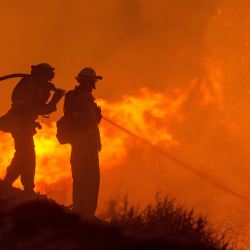The West Coast is aflame; thousands are being evacuated. Before we jump to a conclusion of why, can research inform our thinking? Yes, especially for, "Communities that meet or intermingle with undeveloped wildland vegetation, creating zones known as the wildland-urban interface…."
"Humans' relationship with wildfire in the WUI is a complex interaction between an increasing number of people living in flammable landscapes (increased number of at-risk communities and ignition sources), a warmer and drier climate that is more conducive to fire, and increased fuels accumulated in some places due to years of fire suppression."
We humans have a strange relationship with "the wilderness." Some favor a return to nature, others not so interested in giving up their urban creature comforts, at least, until the time of COVID. That said, human expansion into the wildland-urban interfaced, WUI, has grown steadily for decades with 2.5 million homes now in these areas, 1.75 million people in the western WUI alone. Of course, with humans comes more wildfires, whether due to us or simply because they are more frequently noted.
The researchers set out to see the impact of humans and lightning strikes on wildfires in WUIs, even less developed areas and wildlife areas. They used the U.S. Forest Service Fire Program Analysis-Fire-Occurrence Database of 1.6 million fires between 1992 and 2015, collapsing the various determining causes of fire, e.g., campfires, arson, equip into one category of human-started. Zillow provides a database of home density over time and estimates of the cost of fire suppression from another Federal dataset. Their hypothesis that wildfires were predominantly due to lightning strikes in wildlife areas, humans in the WUI area, and in those lower density areas, a mix. The study defined these areas basically as the home density, greater than 6.17 units/kilometer2 for WUI, less than that for lower density areas, and no homes for wildlife areas. [1] The databases were cleansed of incomplete data and geolocations created mapping Forest Service geolocations to Zillow data – a fair amount of manipulation to bring the datasets together [2]
Results
- WUI, which accounted for 10% of the land, was the site of 32% of all wildfires, and "burned a total of 16,412 km2, representing 4% of the total area burned" fires smaller than those in less inhabited areas.
- Like our rebuilding behavior towards living in flood zones, despite the fire risk, there was a 145% increase in homes (about 32 million) in this area during those years.
- Humans started 97% of fires in WUIs, 85% in those less populated areas, and 59% in wildlife areas burning a total of 173,829 km2, an area the size of Cambodia or Uruguay. The preponderance of those fires were in the West or Southeast
- Human-caused wildfires doubled the "fire season" in WUIs, quadrupled it in the lower density areas, and tripled the length of the fire season in wildlands.
- Human-caused wildfires put 75 million homes at risk [3], lightening 2.7 million
- Over the period of the study, the annual cost of fire suppression doubled to $1.55 billion. 53% spent on WUIs; more of those costs were in the West, where cost was 12 times those in the East.
"This study illustrates how the WUI, which accounts for only a small portion of U.S. land area (<10%), acts as a major source of wildfires, almost exclusively human-caused WUI-originated fires also account for a disproportionate number of homes threatened and suppression costs, relative to its area …making these areas a high priority for policy and management aimed at reducing human ignitions as well as promoting resilience to future fires."
As the authors point out, changing climatic conditions are resulting in more extreme precipitation events, creating "higher fuel loads, both live and dead." Even within that statement lies human decisions. The best of our "science" focused solely on how wildfire affected humans required them to squelched at all costs, including the cost of creating lots more underbrush and kindling. That science was wrong, in part, because it focused solely on our experience of wildfire, not the needs of forests or the accommodations forests have made for lightning over the millennia. But that having been said, it is our behavior, in how and where we build, and how we act that is fueling a significant portion of today's events. I will give the last word to Michael Jackson,
I'm starting with the man in the mirror
I'm asking him to change his ways
And no message could have been any clearer
If you want to make the world a better place
(If you want to make the world a better place)
Take a look at yourself, and then make a change
Notes
[1] As a point of reference with about 32,000 people/km2 in NYC, that is a housing density of 7500 units/km2
[2] Those manipulations do introduce bias, the most important, referenced as a limitation was not including small wildfires, which are mostly attributable to humans but are more easily observed and suppressed. Additionally, the Zillow dataset undercounts housing at least compared to census data.
[3] "At-risk" defined as within 1000 meters of a fire
Source: In the Line of Fire: Consequences of Human-Ignited Wildfires to Homes in the U.S. (1992–2015) Fire DOI: 10.3390/fire3030050

